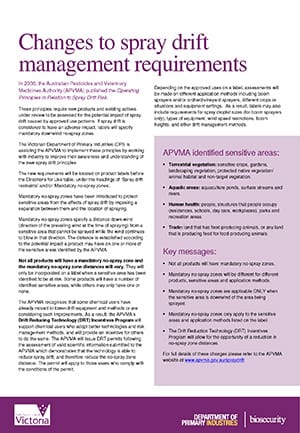|
Off-target spray drift that can accompany the application of pesticides is a concern that sometimes alarms the community and always challenges the agricultural industry to find ways to control it more effectively.
Mandatory no-spray zones have been introduced to protect sensitive areas from the effects of spray drift by imposing a separation between them and the location of spraying.
The Victorian Department of Primary Industries (DPI) is assisting the APVMA to implement these principles by working with industry to improve their awareness and understanding of the new spray drift principles.


Not all products will have a mandatory no-spray zone
Mandatory no-spray zone distances will vary
These principles require new products and existing actives under review to be assessed for the potential impact of spray drift caused by approved use patterns. If spray drift is considered to have an adverse impact, labels will specify mandatory downwind no-spray zones.
Identified sensitive areas:
-
Terrestrial vegetation: sensitive crops, gardens, landscaping vegetation, protected native vegetation/ animal habitat and non-target vegetation.
-
Aquatic areas: aquaculture ponds, surface streams and rivers.
-
Human health: people, structures that people occupy (residences, schools, day care, workplaces), parks and recreation areas.
-
Trade: land that has food-producing animals, or any land that is producing feed for food-producing animals.
Key messages:
-
Not all products will have mandatory no-spray zones.
-
Mandatory no-spray zones will be different for different products, sensitive areas and application methods.
-
Mandatory no-spray zones are applicable ONLY when the sensitive area is downwind of the area being sprayed.
-
Mandatory no-spray zones only apply to the sensitive areas and application methods listed on the label.
-
The Drift Reduction Technology (DRT) Incentives Program will allow for the opportunity of a reduction in no-spray zone distances.
See Also : Chemical Use – Victorian DPI website
Spray Drift – APVMA website
|

